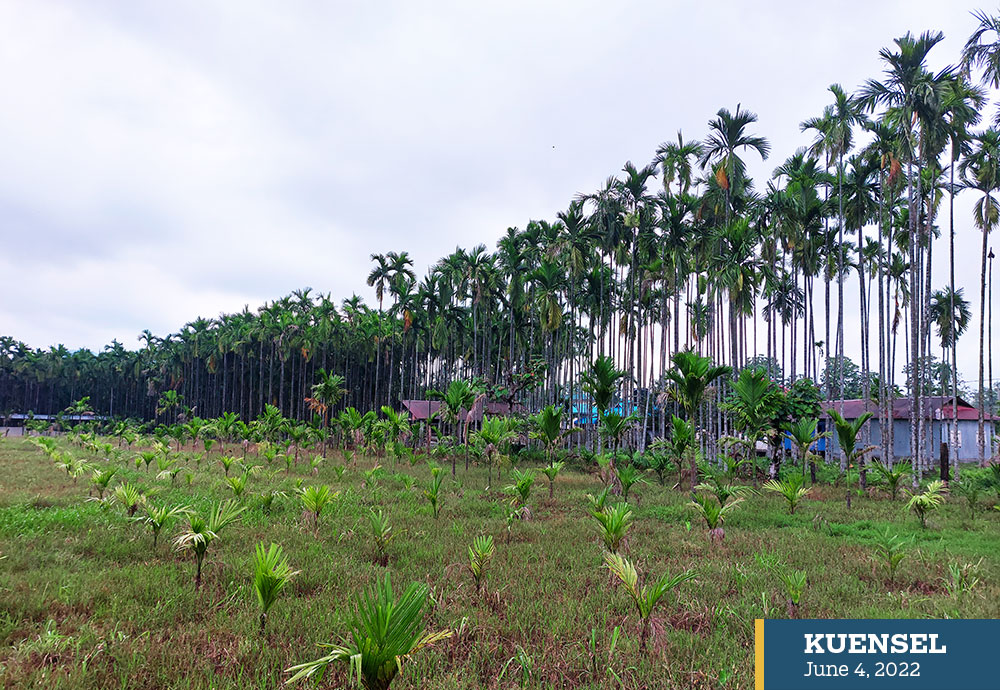Choki Wangmo | Dagana
Amber Gurung, 60, was brought up among the mandarin orchards in Lhamoidzingkha, Dagana. Now, within a few decades, more than half of his orchard is replaced by areca nut trees.
This is not only with Amber. In recent years, the three gewogs—Nichula, Karmaling, and Lhamoidzingkha—under the Lhamoidzingkha drungkhag, have seen drastic change in their farming landscape.
Anyone visiting the drungkhag will first observe the thin and tall doma trees along the roads and among the farmlands.
The national statistics has reported increased areca nut production in Dagana: from 923.31 MT in 2019 to 1,171.81MT in 2020. Lhamoidzingkha Gup Surja Bdhr Limbu said that 60 acres of land in the gewog is under doma cultivation.
In his five-acre land, Amber has planted areca nut trees in three acres. He started the doma business in 1991 after the mandarin yield failed. He said that without market, growing other fruits, crops, and vegetables wasn’t an option for the residents.
“In the past, we focused on growing chillies, but it is not lucrative without access to market,” he said.
He grows rice and vegetables for self-consumption in his remaining land.
According to Khem Prasad Koirala, 85, doma cultivation in the region started in the 1970s. “The government provided saplings from Bhur in Gelephu at Nu 5.”
His son, Laxman, 38, was eight then. Laxman said that within years, everyone started shifting to doma cultivation as it was easier to grow compared to other cash crops. He is a proud owner of 80-decimal orchard.
The price factor triggered the shift in farming, according to residents. Doma, currently, is the main source of income for farmers in the region.
Deoraj said that the erratic monsoon was challenging for residents to grow other crops and vegetables. “We cannot grow crops or vegetables during monsoon. It doesn’t rain, but pours, destroying everything on its way.”
He has 45 decimals of his land under doma cultivation.
Human-wildlife conflict, particularly from elephants, forced farmers to change their way of lives.
Residents said that elephants can damage the areca nut trees too. “We have electric fences but due to frequent power outage, it is of little benefit,” one said.
It takes six years for an areca nut plant to mature. An owner of 70-decimal doma orchard said that the work was tedious in the early stages of cultivation. “The plant requires constant watering, weeding, and care.”
She said that although she tried cultivating other vegetables among doma trees, it was not feasible.
Surja Bdhr Limbu said that according to national laws, people are not allowed to grow other crops like doma in wetlands but residents are helpless.
The human-wildlife conflict, he said had intensified in recent years, and without a compensation scheme in place, residents were discouraged to grow other crops and vegetables.
Due to land fragmentation, some farmers couldn’t use the land for other purposes. “Some owners live in other dzongkhags and visit occasionally to care for plants and during harvest season,” he added.
In Nichula gewog, gup Nima Wangchuk Sherpa said that there was no assessment of how much land is under doma cultivation. But, the change in farming landscape, is no different from that of Lhamoidzingkha gewog.
However, farmers are vulnerable and are worried as the areca nut trees are affected by a disease in the last two years.
A resident said that the leaves of the trees yellowed from the tip and dried up. “Our main source of income would be cut short. Without other options, our livelihood would be affected,” she said.
The gup said that there was no study of the disease but there were reported infections in the plants. “Trees are dying without fruiting.”
Some said that the yellowing was caused by water shortage.
Without a reliable export route, doma exporters pay a high price to transport the produce.
Areca nut is one of the major fruits grown in the country. In 2020, there were 1,767 hectares of areca nuts, up from 1,747 hectares in the previous year.
According to the Food and Agriculture Organization, although Bhutan’s areca nuts yield fluctuated substantially in recent years, it tended to increase through 2001 – 2020 period.


